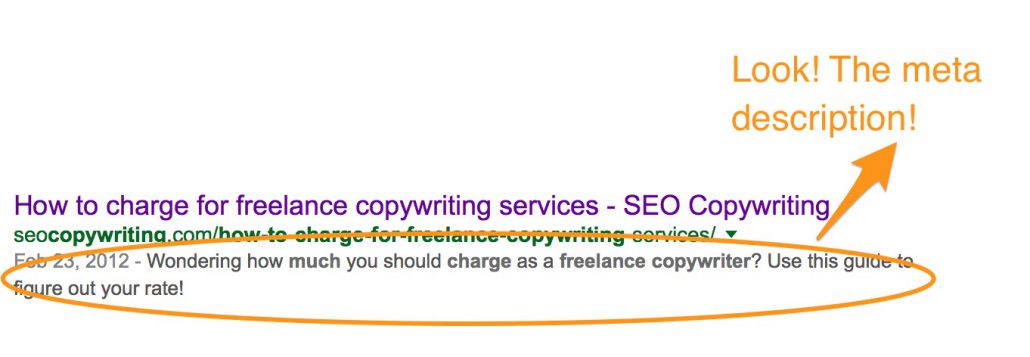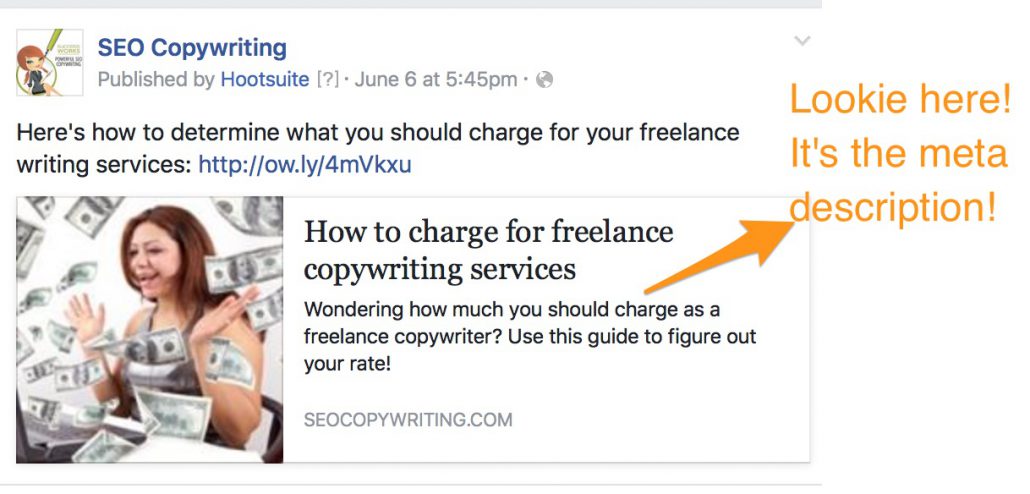Should You Still Create Meta Descriptions in 2016?
Do you want more people to click on your search result — even if you’re not #1?
Masterfully-written meta descriptions have tremendous traffic-boosting powers.
In fact, Neil Patel has stated, “The meta description is the most important feature for improving click-through rate from search results pages.”
What’s more, you can write a great meta description in five minutes or less!
Here’s everything you need to know:
What’s a meta description?
The meta description is an HTML attribute summarizing the page content. In less geeky terms, the meta description proves a mini-summary of the page and describes what it’s about.
The meta description does not have an SEO benefit, although a strong meta description may entice people to click on your search listing.
(And this is where the magic happens!)
Here’s what the meta description looks like on the search engine results page:

If you’re using an SEO plug-in, you’d insert your meta description in a field like this (this is from the Yoast SEO plug-in):

Or, if you’re checking out the behind-the-scenes code, the meta description looks like this:
<meta name>=”description” content=”Wondering how much you should charge as a freelance copywriter? Use this guide to figure out your rate!” />
Now, here’s where things get really interesting…
Remember I mentioned the magic in meta descriptions?
Here’s why:
The meta description shows up when you share a post on social networks:

Plus, a masterfully-written meta description can tempt users to click on your listing over others on the search engine results page:

See what’s happening here? The meta description helps “sell” the listing and encourages readers to click through.
Think of the meta description as “ad copy” rather than “back-end code,” and you can really grasp the importance.
The better your meta descriptions, the more of a chance you’ll see search and social traffic — especially when paired with a killer Title.
Plus, they’re fun (and easy) to write.
Here’s how:
5 masterful meta description-creation tips:
You’ll want to create an unique meta description for every page on your site, so it’s important to write them right.
1. Know your (character count) limits
In the past, we had about 156 characters (including spaces). Recently, Google has been testing longer descriptions — and now, you have approximately 200 characters (including spaces.) More than that, and Google will slice off your listing and show the dreaded ellipses (…)
Want to make sure you don’t push the character count limit? SEO plug-ins like Yoast’s and tools like Snippet Optimizer show you what your meta description will look like on the search engine results page.
2. Think “clickable”
The meta description helps your listing pop off the search results page — so you’ll want to write to get the click. Use action-oriented words and a call to action to invite readers to learn more.
For instance, let’s unpack Moz’s meta description:

This masterful meta description for the Moz home page includes:
Social proof: “the largest community of SEOs on the planet”
Benefit statement: “Moz builds tools that make inbound marketing easy”
A call to action: “Start your free trial today!”
That’s a lot of brilliant writing within a very limited character count.
3. Clearly describe what the page is about
Yes, you want to be compelling — but you don’t want to write a cutesy, click-bait meta description that doesn’t match the page’s intent.
Think about it: people are busy. Why would your reader click on something when they weren’t 100% sure it would answer their question (or solve their problem.)
After all,
Am I right? :)
4. Include keyphrases, but don’t keyphrase stuff
Keyphrases in your meta description won’t help your SEO. However, it could help your click-throughs. Here’s why:
- The keyphrases will be bolded in the search listing. So, if someone searched for [blue widgets], the words “blue widgets” will show in the meta description.
- Using keyphrases and related words reassures searchers your landing page contains the information they want.
So yes, include a keyphrase if it makes sense…but focus more on getting the click. Including…
5. Experiment with different CTA formats
Adding a CTA to your meta description can drive more eyeballs to your site — or even calls to your company.
For instance:
- Does your business thrive on phone calls? Try including your phone number.
- Raven Tools recommends action-oriented verbs like, “buy,” “shop”, “click.” “Read more” is a popular blogging CTA.
- Neil Patel discusses how the meta description should “spark curiosity.” For instance, here’s a description that makes you want to learn more:

Match the CTA to the page’s intent and don’t be afraid to try different things. You never know what will spark the click and drive fantastic results!
Do you need more back-to-basics SEO writing tips? I share my best secrets in my free newsletter. Sign up now!




Really important tips for meta descriptions writing!
Thanks for this valuable tips.
I always suggest to my clients to do the meta description. I mean, it doesn’t take *that* much time and it can only help!
Meta description is still one of the vital essences of creating traffic for a website, it should always be imprinted on every SEO minds!